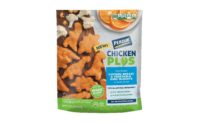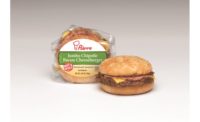The snacking sector is increasingly rich with opportunity for meat and poultry merchandisers.
While the traditional core items such as candy, cookies, chips, pretzels, ice cream, yogurt, crackers, cheese, nuts, popcorn and fruit remain the most popular snack foods, meat and poultry-based selections are generating greater interest as more wellness-oriented consumers pursue options with protein and other healthy ingredients.
With many people, particularly younger shoppers, snacking throughout the day in lieu of eating three meals, the demand for more filling varieties is rapidly expanding, analysts say.
Major meat snacks include jerky, bars, sticks and bites containing beef, chicken, pork, turkey and salmon, along with products that feature meat combinations and are available in resealable packaging, reports Information Resources Inc. (IRI), a Chicago-based market research firm.
Newer alternatives include zero-sugar and grass-fed selections and such flavors as chorizo beef and pork and black pepper, IRI says.
In addition to becoming more prevalent in a host of retail channels such as supermarkets, convenience stores, dollar stores and supercenters, meat-snacks options are expanding at foodservice locations.
A rising star at foodservice
Chicken and shrimp are the most prevalent protein snacks on the menus of the 500 largest restaurant chains, according to Technomic Inc., a Chicago-based food industry research and consulting firm. Chicken wings, strips and nuggets are among the most common offerings.
Thirty-nine percent of consumers say chicken dishes and appetizer samples are their top meat choices when using appetizers or entrees as snacks (versus baked goods, side dishes and beverages), Technomic shows in its 2018 Snacking Consumer Trend Report.
Other popular meat-based snacking options at foodservice outlets include mini burgers and sliders (which 20 percent of consumers favor); meat and charcuterie plates (15 percent); and meatballs (12 percent), Technomic says, adding that other meat-oriented selections, such as sandwiches, salads, pizza and tacos, also are popular snack selections.
“Meat snacks are high in protein and filling and can be a particularly good option for those snacking as a meal replacement,” says Anne Mills, Technomic senior manager of consumer insights. She says Technomic research found that 52 percent of consumers agree “high in protein” is a very appealing snack attribute.
More people, meanwhile, also are viewing meat and poultry as a “mini meal” rather than just a snack between meals, says Tom Super, senior vice president of the Washington, D.C.-based National Chicken Council.
He says the two important meat snack-buyer segments are traditional consumers who eat jerky on a regular basis as a snack or part of a meal, and the growing market of shoppers who seek protein and perceive meat snacks to be healthy and convenient options that can sustain them when traveling or taking part in outdoor activities.
“Appealing to both categories at the same time with the same product is a marketing challenge,” Super says.
Yet, because meat snacks have the advantage of being more nutritious than most traditional salty snacks, merchandisers are in position to appeal to a wide range of consumer segments, says Jim Wisner, president of Wisner Marketing Group, a Lake Forest, Ill.-based retail consultancy.
“The operative word is ‘protein,’ which is very important to most individuals, and meats have the most protein,” he says.
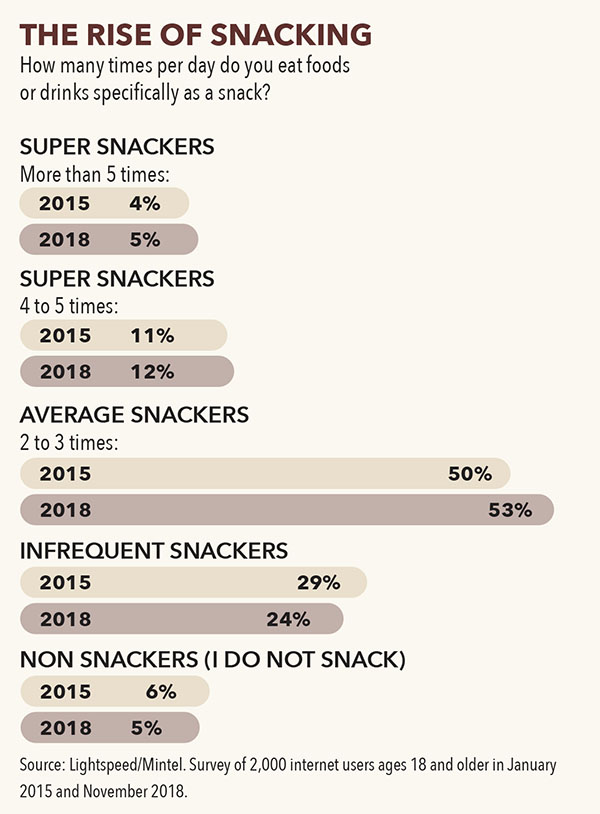
With more consumers using snacks as meal replacements and younger persons in particular eating smaller portions more frequently throughout the day, “protein-rich items, and especially meat products, fill the bill,” Wisner says.
Though more shoppers also seek traditional cuts of fresh meat for snacking, he says the packaged-goods sector remains active with jerky sales vibrant as merchandisers offer newer and more diverse varieties. Products include those made from bison, wagyu beef and grass-fed cattle. Biltong — a dried, cured, spiced meat similar to jerky — also is becoming more prevalent, he says.
“Jerky used to primarily just be available in glass jars in convenience stores, but many food retailers now have eight-foot displays in stores with a zillion different styles, flavors and cuts,” Wisner says. “The greater interest in protein snacks has a lot to do with it.”
Sales of jerky products and snacking combos that include meat with such items as cheese, crackers and nuts have generated strong revenues over the last year. The sectors have seen dollar and unit growth of 9.4 percent and 7.2 percent, respectively, says Meagan Nelson, associate director at New York-based market research firm The Nielsen Co.
New growth opportunities abound
The increasing popularity of snacking is resulting in more innovations from product developers, including suppliers of bacon and lunchmeats, according to Mintel Group Ltd., a Chicago-based market research firm.
“Snack-friendly products are not only a solution to expanding beyond traditional mealtimes, they are also a potential way to further engage small households who may not need multiple types of bacon and lunchmeat but would be receptive to a few different snack options,” Mintel reports in its October 2019 Bacon and Lunchmeat U.S. report.
Such products are most likely to resonate with young consumers who snack most frequently and are some of the least engaged consumers in the bacon and lunchmeat categories, Mintel says.
“Additionally, snack-friendly products have gone mostly untouched by private-label brands, suggesting snack innovation is a way for brands to differentiate themselves and grab consumer attention,” Mintel adds.
With 30 percent of salty-snack eaters saying they are reducing consumption, other snack options are becoming more viable, Mintel reports in its March 2019 Salty Snacks U.S. report.
“The strong demand for snacks has resulted in an expanded view of what constitutes a snack, which can challenge traditional snack categories,” Mintel says. “While continued growth is projected for salty snacks, a slower pace is expected through 2023.”
Mintel says salty-snack brand operators “will need to stay on their toes” to fend off competition, which includes merchandisers of meat and poultry snacks, as products from traditional non-snack sectors make a play for snack occasions.
“Salty snacks perform well for flavor, satisfaction and portability compared to other snack categories, but struggle with being perceived as too high in calories,” Mintel says, adding that the majority of category participants say salty snacks are better as an indulgence than as a healthy snack.
Meat-snack eaters, meanwhile, are more likely to prioritize low price and filling and portable options. Low calories and low sodium are two of the leading attributes that appeal to consumers seeking healthy snacks, Mintel reports, noting that brands will need to assure such consumers that lower-sodium varieties will continue to deliver on flavor.
Highlight the high points
Merchandisers seeking to boost meat-snack activity also should spotlight such product attributes as convenient eating, inviting textures, simple ingredients, a variety of forms, unlimited flavor combinations and multiple packaging options, says Sally Lyon Wyatt, IRI executive vice president and practice leader.
Selections will continue to evolve over the next five years, she says, adding that consumers’ quest for high protein and inventive options will result in an increasingly greater interest in meat snacks.
“Innovation within flavor and packaging, along with nutrient-rich ingredients, will keep on spurring growth of meat snack sales,” Wyatt says.
Rollouts of new meat and poultry snack options already are proliferating in the U.S., with product launches growing at about a 15 percent compound annual growth rate (CAGR) from 2016 to 2018, according to Innova Market Insights, an Arnhem, Netherlands-based market research firm focusing on the global fast-moving consumer goods and food and beverage sectors.
Selections with smoked, teriyaki, pepper and barbecue flavors are becoming more prevalent with the varieties present in about 30 percent of the new meat-snack products since 2016, Innova reports.
Yet, “the door also is open to companies that attempt to go outside of these favorites,” says Tom Vierhile, Innova vice president of strategic insights, North America. He notes that spicy flavors may hold the most promise with jalapeno and black pepper growing quickly and sweet flavors such as maple also becoming more popular.
Unconventional meat-snack flavors with strong growth potential are beer, whiskey, Buffalo wing, chili lime, salt and vinegar, cinnamon and bourbon, he says.
“Meat types like bratwurst or Italian sausage are popular in their own right but have never really been able to transition to meat snacks,” Vierhile says. “But certain smoked flavors that are closely aligned with specific types of meat, such as applewood bacon and brown sugar, may be underutilized in snack foods. It pays for merchandisers to keep close tabs on developments in flavor innovation and consumer preferences toward specific ingredients so that they are not caught off guard.”
Many nutrition-conscious shoppers, meanwhile, are seeking products with simple ingredients, such as vinegar, salt, black and red pepper and coriander, the National Chicken Council’s Super says. Adventuresome meat-snack consumers show interest in bolder flavors and exotic proteins such as venison, antelope, waterfowl, rooster meat, capons and specifically fed birds.
Product developers, he adds, can generate further interest in chicken snacks by offering such flavors as teriyaki, rotisserie, barbecue and other common chicken meal tastes. Developers also can include fruits such as apples, blueberries, blackberries and pineapple in products.
“It is difficult for supermarkets to feature these products in their weekly advertisement flier or online communications with shoppers because of limited on-shelf inventory,” Super says. “However, in-store taste-testing stations that not only give out samples but provide attractive coupons the Fridays before the big games on the weekend will move product.”
Merchandisers also should not be afraid to “fast fail” by making slight modifications to their meat-snack product mix to keep customers intrigued, says Jason Menke, director of marketing communications with the Des Moines-based National Pork Board.
“Stick to your best sellers, but offer a new flavor or product,” he says. “Don’t be afraid to elevate your offerings with artisanal flavors or unexpected ingredients.”
Concentrate on consumer convenience
Along with providing meat snacks in exciting and novel flavors, retail operators should make products easy for shoppers to access, says Eric Richard, industry relations coordinator for the Madison, Wis.-based International Dairy-Deli-Bakery Association (IDDBA).
“Convenience is a big element in consumer shopping habits with many seeking to get in and out of stores quickly,” he says. “That is where in-store delis can capitalize by offering meat snacks, either stand-alone or paired with other offerings, in single-serve, grab-and-go packaging.”
He says in-store deli operators can create appealing snacks displays by situating a variety of items such as meat, cheese and nuts in convenient grab-and-go cases that retailers can locate in different areas of the store “so more eyes will set it.”
Along with spotlighting the protein content, merchandisers can boost shopper interest in meat snacks by publicizing such attributes as freshness and local or regional ties through labels, case signage, social media and on websites, Richard says.
“More consumers are reading labels, and clean labeling is one of the top trends,” he says. “Shoppers, and especially younger generations, are looking for more transparency in their foods, which includes knowing where the items come from and the ingredients.”
Because shoppers are not necessarily going to be aware of the availability of meat snacks in delis, Richard says “it is important to make the products obvious and for delis to be known as snacking destinations. Use in-store signage, labeling and marketing channels and, because convenience is key, make it easy for shoppers to find what they are looking for and quickly be on their way.” NP
Jerky: Far from Murky
Beef jerky remains a popular meat snack, but producers are not resting on their laurels.
The thin slabs of dried, seasoned beef are showing up in more flavors and with higher-quality ingredients, according to Datassential, a Chicago-based market research firm.
“No longer limited to a simple smoky flavor, this lean, high-protein snack now comes in flavors ranging from raspberry chipotle to clover honey,” Datassential notes in a 2018 report on the sector. “Beef jerky also is leveraging more premium meats to be in line with consumer preferences.”
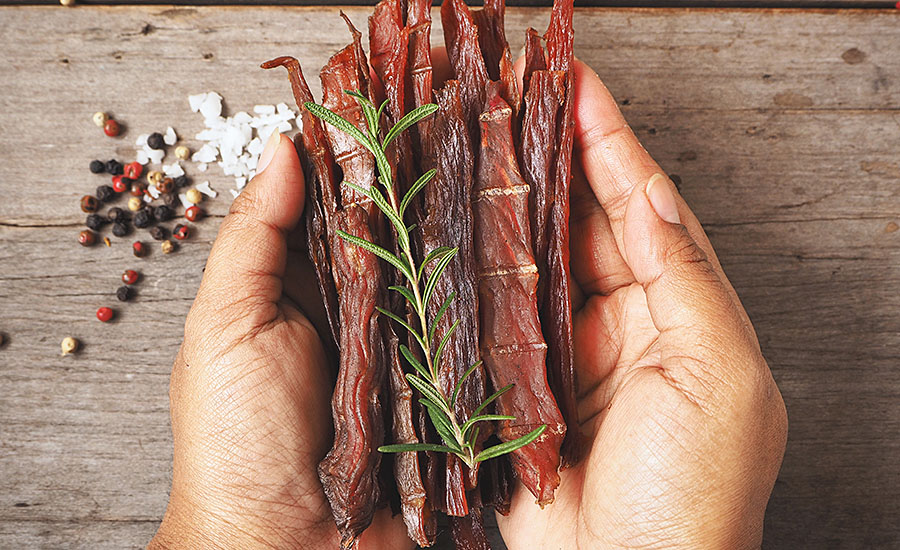
Datassential says that while beef jerky retains its traditional perception as the “quintessential” snack for road trippers, hikers and campers, “recently it has been resonating with on-the-go consumers looking for health-forward snacks with on-trend functional benefits like filling protein.”
In addition, the rise of gluten-free and Paleo diets is generating further interest in jerky, Datassential notes, adding that besides offering a wider variety of flavors, artisanal and small-batch processors are focusing more on ingredient quality. That includes using grass-fed, antibiotic-free and hormone-free meats while eschewing artificial flavors and preservatives, the firm notes.
The appeal of beef jerky is stretching “to include anyone looking for a relatively healthy on-the-go snack,” Datassential reports. “As American tastes continue to expand into more varied and authentic ethnic cuisines, expect the variety of spices and flavors of beef jerky to expand as well.”
Developers of meat jerky, meanwhile, are enjoying the fruits of the increasingly active market.
Production revenues grew at an estimated annual rate of 3.4 percent to $1.3 billion between 2013 and 2018, reports IBISWorld, a Los Angeles-based market research firm, in its December 2018 Meat Jerky Production in the U.S. report.
“Despite the falling price of red meat, growth in per capita meat consumption helped boost industry revenue,” IBISWorld reports.
Product innovation has been the primary driver of the increased activity, as developers alter ingredients in response to the segment of consumers who view jerky as being unhealthy and full of artificial flavors, preservatives and sodium, IBISWorld says.
Some product developers are battling that perception by emphasizing the artisanal nature of jerky and using lean sources of protein.
IBISWorld forecasts sector revenue growth to slow to 2.7 percent annually to $1.5 billion by 2023 because of the growing number of snacking options for consumers.
“Despite Americans’ increased budgets, industry operators will likely experience greater competitive pressures from alternative snack food providers, which will limit revenue opportunities,” IBISWorld reports. “Additionally, per capita meat consumption is expected to grow more sluggishly, slowing revenue growth during the period. Overall, new product development and increased demand from consumers looking for convenient food and new, exciting flavors will support industry performance.”
— Richard Mitchell
Snacks by the numbers
In its 2018 Snacking Survey, Information Resources Inc. (IRI), a Chicago-based market research firm, found 75 percent of consumers want snacks guaranteed fresh, 58 percent want snacks that contain vitamins and minerals, 57 percent want snacks that are all-natural or made from natural ingredients and 44 percent prefer snacks made with whole grains.

In addition, 86 percent of consumers look for snacks that are a good value for their money, 56 percent eat snacks that have convenient portion sizes and 50 percent consume snacks that add excitement to their daily diet, IRI reports.
Fifty-seven percent of consumers, meanwhile, want snacks that can be eaten on the go and feel that fat and sugar information on packages is important, while 50 percent say shopper loyalty-card discounts influence their snack choice and 38 percent say snacks found at the checkout spur their purchase decision.
As they respond to such shopper interests, product developers should continue to innovate for lifestyle changes across generations. Seasonal innovation and assortments also are key for additional growth, Sally Lyon Wyatt, IRI executive vice president and practice leader, noted in a 2018 presentation on the snacking sector.
She says it is important for merchandisers to develop and enhance exciting flavor combinations that appeal to the U.S. palate and to look to foodservice for emerging trend inspiration and potential collaboration.
To spotlight product attributes, Wyatt advises merchandisers to “leverage packaging as your billboard community, your differentiation and benefits. Channel strategies, unique positioning and assortment will win”
Niche snack categories such as meat, she adds, tend to be successful when ingredients, flavors and packaging are “premiumized.” Wyatt reports the meat snack sector had a 10.9 percent dollar share in 2017, up 8.3 percent from three years earlier and outpacing the mainstream by 4.7 points.
Bacon-flavored snacks, meanwhile, are a “fan favorite,” she says, with 37 percent of consumers saying they love eating the selections and 38 percent indicating bacon-flavored snacks are a good way to satisfy their craving for bacon.
Thirty-four percent of consumers also want exotic flavors, and 91 percent want snack flavors they prefer, IRI reports.
— Richard Mitchell
Challenging Landscape
While the popularity of meat and poultry snacks is expanding, merchandisers seeking to maximize revenues must still overcome a host of challenges.
Despite the presence of protein in the products, for instance, some health-oriented shoppers remain reluctant to try them because of sodium and cholesterol concerns, says Sally Lyon Wyatt, executive vice president and practice leader for Information Resources Inc. (IRI), a Chicago-based market research firm.
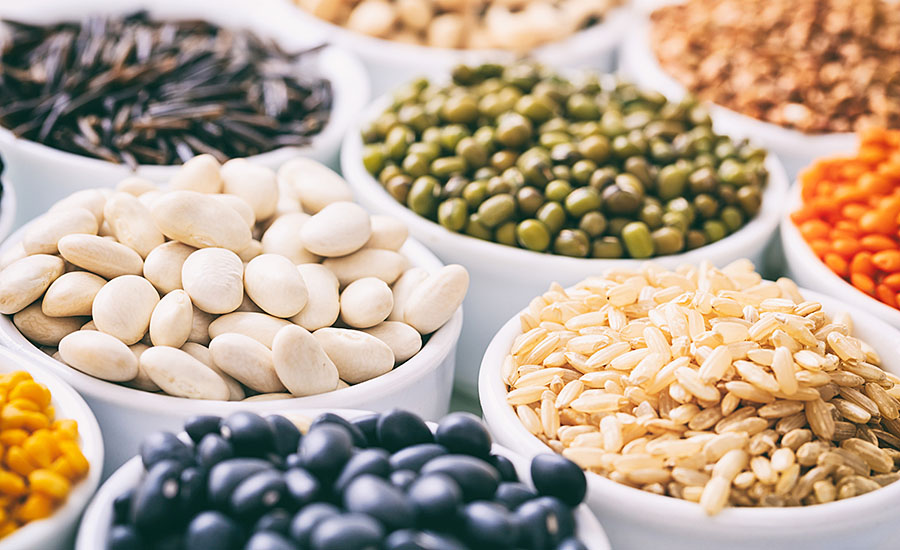
Animal-welfare concerns and the need for merchandisers to effectively market to a variety of consumer segments that have different attitudes toward meat snacks are further sales obstacles, she says.
“It is important to understand shoppers’ needs in each outlet to achieve optimal sales,” Wyatt says, adding that retail operators also should situate meat snacks in multiple store locations to attract different shopper groups.
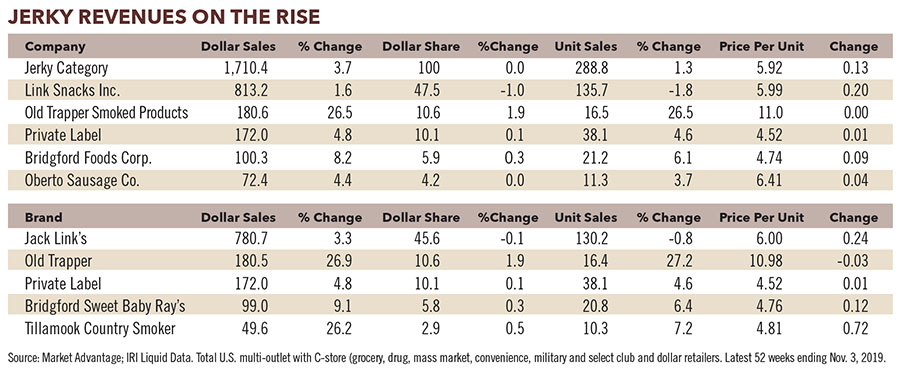
That may include placing items in areas with other protein products as well alongside selections that are part of popular diets such as Paleo and near wellness-oriented offerings, including low-sodium and plant-based foods, Wyatt says.
“These efforts will enhance awareness of the category and the snacks that address specific shopper needs,” she says. “Optimized assortment is critical to ensuring continued success.”
Merchandisers also will benefit from leveraging social and digital marketing tools that tailor messages to different consumer segments and offer coupons and/or discounts, while having social influencers share their experiences with the meat snacks, Wyatt says. “Sharing news or ideas by personalizing data will enable retailers to attract and retain meat-snack buyers.”
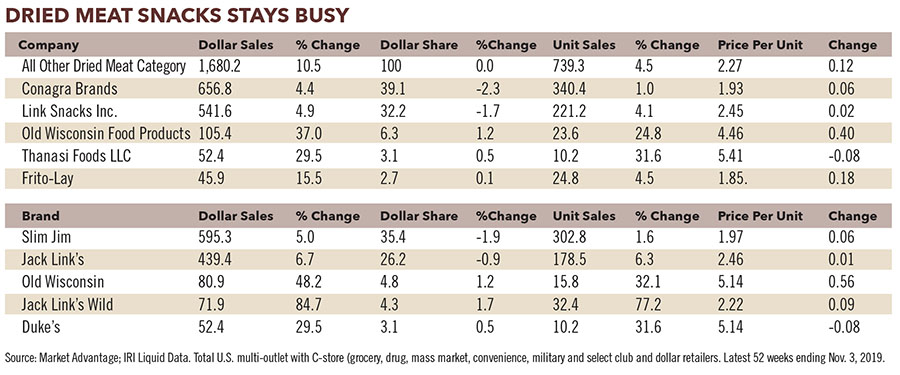
The strongest meat-snack sales increases are coming from upper-income Generation X consumers who have more than two people and mixed ages in their households, while “teens and Millennials are fans of the category as well,” she says.
It often can be difficult for merchandisers to boost interest in fresh meat snacks because salty snacks tend to be more portable and less costly — two major sector sales drivers, says Anne Mills, senior manager of consumer insights for Technomic Inc., a Chicago-based food industry research and consulting firm.
She says “relatively affordable meats” such as handheld boneless chicken tenders are perhaps most likely to be successful.
In addition, the growing popularity of snacks with plant-based ingredients will add to the burden of increasing meat-snack activity, Mills says.
“Utilizing poultry versus red meat may help appeal to non-vegetarians who choose plant-based options for health reasons,” she says. “Merchandisers can offer smaller portions and keep meat snacks simple to help lower costs.”
Keeping pace with evolving shopper interests is important for product developers as “there are so many new items, so much new technology and so many changes in eating behavior that breaking through and acquiring a level of importance in the retailers’ eyes so they will prioritize products is difficult,” says Jim Wisner, president of Wisner Marketing Group Inc., a Lake Forest, Ill.-based retail consultancy.
Offering plant-based snacks and other meat substitutes, meanwhile, will enable meat and poultry product developers to expand their market, he says.
“Think of yourself less as a seller of meat and more as a seller of protein,” Wisner says. “Producers have to go with the flow to where the market takes them.”
That includes merchandising items with cleaner labels and publicizing such attributes through digital marketing, social media and on-shelf signage, he says.
“Products with fewer preservatives will help keep the meat-snack category viable and important,” he says. “That trend will not be going away anytime soon.”
The growing number of young consumers seeking to avoid meat and embrace vegan and vegetarian eating also presents a meat-snack sales hurdle, says Tom Vierhile, vice president of strategic insights, North America, for Innova Market Insights, an Arnhem, Netherlands-based market research firm focusing on the global fast-moving consumer goods and food and beverage sectors.
“The category is seeing a lot of non-meat alternative snacks made from ingredients like mushrooms and fruit that present a challenge to merchandisers trying to keep up with all of the category changes,” he says.
The growing consumer interest in plant-based ingredients could crimp traditional meat-snack sales, but he says it presents an opportunity for merchandisers to broaden their product lines and appeal.
“There is a spike in global new-product launches featuring verbiage like ‘plant-based,’” Vierhile says, adding that the compound annual growth rate (CAGR) for food and beverage launches featuring the term grew by 68 percent from 2014 to 2018.
— Richard Mitchell


